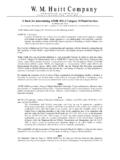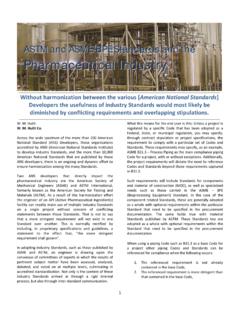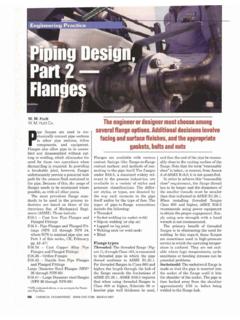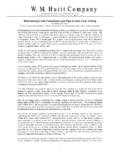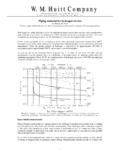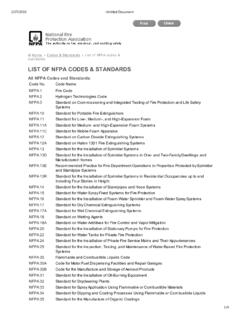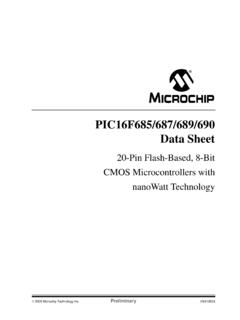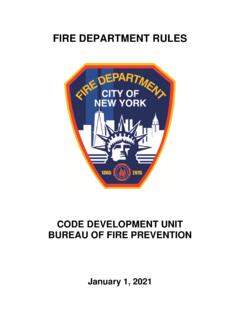Transcription of High Purity Process Piping: Harmonization of ASME Codes ...
1 1 PHARMACEUTICAL ENGINEERING MARCH/APRIL 2014facilities and equipmentRegulatory HarmonizationHigh Purity Process piping : Harmonization of asme Codes and Standardsby Barbara Henon, Vince Molina, Richard Campbell, and William HuittThis article presents interactions between the asme Bioprocessing Equipment (BPE) Standard and asme Process piping Code Committees following the addition of Chapter X high Purity piping to the 2010 Edition of This collaboration of asme Committees will help to assure both safety and cleanability of high Purity piping ollowing the introduction of the asme Bioprocessing Equipment (BPE) Standard in 1997, most new pharmaceutical and biotechnology plants around the world have been constructed using the asme BPE ,2 The original scope of this standard, as approved in 1989 by the asme Council on Codes and Standards stated.
2 This standard is intended for design, materials, con-struction, inspection, and testing of vessels, piping , and related use in the biopharmaceutical industry. The asme Process piping Code also includes piping in pharmaceutical plants as being within its The BPE Standard references asme , but there are inherent differences between the two asme documents that have only recently been addressed. While the focus of the Code is primarily on safety issues, the 2010 Edition of asme introduced a new chapter, Chapter X high Purity piping . Chapter X covers piping in high Purity industries including the semiconductor and bioprocessing industries that have a particular need for cleanness and/or cleanability of their piping systems, but also must meet the safety requirements of the Code. Although the asme Code and the asme BPE Standard have been developed independently, it is impor-tant going forward that they do not contradict or conflict with one another.
3 The addition of Chapter X is an essential first step in closing the gap between the requirements and intent of the asme BPE Standard and the Code. Even before the publication of Chapter X, members of both asme Com-mittees have been working together to harmonize the two asme documents for which the latest editions of both are Purity PipingThe need for a chapter in the asme Process piping Code to address high Purity concerns became apparent in 2004 when an engineer and a member of the Code Commit-tee started to write a specification for an Ultra- high Purity (UHP) piping installation using the asme Code. He found that Process piping systems typically used in semicon-ductor plants were not adequately addressed in the Code. This was the case even though the Code identifies piping in semiconductor plants as within the intended scope.
4 The semiconductor industry uses standards written by Semicon-ductor Equipment and Materials International (SEMI) that reference asme ,5 The emphasis of the SEMI stan-dards is on cleanness rather than the basic safety consider-ations of asme fromPHARMACEUTICAL ENGINEERINGTHE OFFICIAL TECHNICAL MAGAZINE OF ISPEMARCH/APRIL 2014, VOL 34, NO 2 Copyright ISPE 2014 PHARMACEUTICAL ENGINEERING facilities and equipmentRegulatory Harmonization Semiconductor industry practices are based on the requirements of fabrication facilities for UHP fluids that are used in the Process Achieving UHP levels of cleanness in fabrication of Process gas lines was necessary in order to increase the yield of semiconductor integrated Gas storage and delivery systems must not add impurities to the fluids that typically range in Purity from to for chemical and particulate contaminants.
5 These gases may be highly toxic, pyrophoric (spontaneously combustible in air) or corrosive. Major advances in fluid handling and fabrication technology were essential to meet the demands for both Purity and Welding TechnologyIn the 1980s and 1990s, fabricators in the semiconductor industry began using autogenous orbital Gas Tungsten Arc Welding (GTAW) for joining Process gas lines because the smooth inner weld bead resulted in cleaner systems than could be achieved with manual welding. Orbital welding was part of the drive to reduce particulate contamination to very low levels. Welds that are fully penetrated to the Inside Diameter (ID) surface with a smooth inner weld bead are far less likely to entrap particulates than the manual socket welds that were previously used, and cleaner systems were essential to achieving higher product yields.
6 Ultra- high Purity (UHP) and high Purity (HP) semi-conductor piping installations use mostly small diameter Type 316L stainless steel tube, inch, inch, and inch Outside Diameter (OD) rather than pipe. Tube is more suitable than pipe for high Purity applications since it is manufactured with tighter dimensional tolerances than pipe, thus increasing the repeatability of automatic welds. Fittings, valves, and other components for semiconductor systems are highly specific to the type of application. piping systems in other industries covered in the asme Code include piping typically found in petroleum re-fineries, chemical, textile, and paper plants that, for the most part, consist of metallic pipe installed with multipass manual welds with filler metal added to the weld. Orbital welds on tubing are typically single pass welds with a flat or slightly concave OD profile.
7 Neither automatic orbital welding nor helium mass spectrometer leak testing, commonly used for testing of semiconductor Process gas lines, had been ad-dressed by the asme Code prior to the 2010 Coupon ExaminationThe semiconductor industry uses a different type of weld examination from those previously listed in the asme Code. Because of the repeatability of orbital welding and the impracticality of radiographic (or ultrasonic) examina-tion on small diameter, thin-wall tubing, the semiconductor industry uses a quality assurance system of weld coupon examination in which sample welds are made prior to and during production at specified times such as the beginning and end of each shift, and after a change of power supply or purge gas source, etc. The weld coupons are sectioned (cut open) and examined visually for full penetration, discol-oration, alignment, cracking, porosity and other specified defects.
8 If a defect is found, previous welds are cut out and production welds discontinued until the weld problem has been identified and Bioprocessing Equipment (BPE) StandardIn the mid 1980s, mechanical contractors in the emerg-ing bioprocessing industry began to use the same fabrica-tion technology as the semiconductor industry. Repeatable smooth welds are essential to assure the cleanability of bioprocess tubing systems to limit or minimize the growth of microorganisms in bioengineered pharmaceutical products. The initial impetus that eventually led to the development of the asme Bioprocessing Equipment (BPE) Standard was bioprocessing equipment imported from Europe that had manual welds that did not meet the quality standards that were routinely achieved by installers in the United States using orbital welding equipment.
9 Volunteers working on the asme BPE Standard commit-tee have helped to systematize the installation of biopharma-ceutical Process tubing. The Subcommittee on Dimensions and Tolerances specified controlled material chemistry, especially sulfur, to minimize heat-to-heat variability in the weldability of tubing and fittings made from Type 316L stainless steel (and other austenitic stainless steels) and by standardizing the dimensions of weld ends on fittings and other Process components to be orbitally welded. The Subcommittee on Surface Finish set standards for smoothness of product contact surfaces while the Materials Joining (MJ) Subcommittee established weld criteria for prod-uct and non-product contact surfaces of orbital tube welds. Acceptance criteria for welds on tubing systems do not allow cracks, lack of fusion, incomplete penetration, porosity open to the surface, inclusions open to the surface nor undercut.
10 Systems made from nominal diameter pipe are seldom used for the higher Purity requirements in the biopharmaceutical industry. If they are used, the welds are made in accordance with asme Table with additional acceptance criteria of the asme BPE Standard in which cracks, lack-of-fusion and incomplete penetration are prohibited. The MJ Subcommittee also established methods of weld examination and inspection that are not used routinely in other industries. The asme BPE Standard requires visual examination of the outside diameter surface of 100% of tube welds and the use of borescopic or direct visual examination to view the ID of 20% of the tube welds. BPE requires sample welds or coupons be performed prior to production welding and at specified times. Weld logs and weld coupon logs are 3 PHARMACEUTICAL ENGINEERING MARCH/APRIL 2014facilities and equipmentRegulatory Harmonizationpart of quality assurance with every weld numbered, docu-mented and identified on an isometric drawing or weld map.

